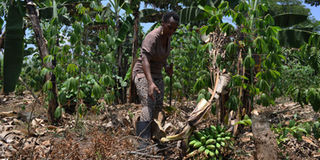Why banana is under threat

The fungus lives in the soil and attacks the roots of the Cavendish banana before spreading to the rest of the plant causing yellowing of the leaves. FILE PHOTO
What you need to know:
- This is the reason they are keen to preserve the Madagascar banana wild relative of the Cavendish which has only about five trees still standing in the entire world.
- The Madagascar banana, believed to have special properties, could provide the genes to use against the Panama Disease.
A dangerous fungal disease could wipe out the Cavendish (bogoya), one of the most consumed type of bananas across the world, says a recent article in the BBC News by Helen Briggs.
The incurable Panama Disease which for years has been confined to Asia is now present in the middle-east, Africa, and Australia.
The fungus lives in the soil and attacks the roots of the Cavendish banana before spreading to the rest of the plant causing yellowing of the leaves.
It also produces spores which survive in the soil for decades and makes the land unusable for non-resistant banana crops.
People may carry the deadly fungus on the soles of their shoes or on the car tyres, moving from an infected area. The disease is also spread by strong winds.
It has almost destroyed the entire Matanuska banana plantation in northern Mozambique where it was allegedly introduced through the boots of two workers from the Philippines.
Another BBC News article by Kim Gittleson says the type of bananas grown for sustenance in Uganda is thought to be resistant to the disease but no one really knows for sure.
Dr Jerome Kubiriba, head of the Banana Research Project in NARO, has said Ugandan scientists are aware of the Panama disease’s presence in Mozambique and they are following its story very closely.
Uganda is already losing its banana crop due to the incurable Banana Bacterial Wilt Disease and the Panama Wilt; any news of an impending banana disease must be very upsetting.
Kubiriba advocates immediate destruction of all diseased plants. Scientists believe that one way to fight Panama Disease is disinfecting farm tools and the feet and car tires of people going to the farm.
They are also considering creating a hybrid with a rare Madagascan wild relative of the Cavendish and also trying out genetic engineering.
This is the reason they are keen to preserve the Madagascar banana wild relative of the Cavendish which has only about five trees still standing in the entire world.
The Madagascar banana, believed to have special properties, could provide the genes to use against the Panama Disease.




